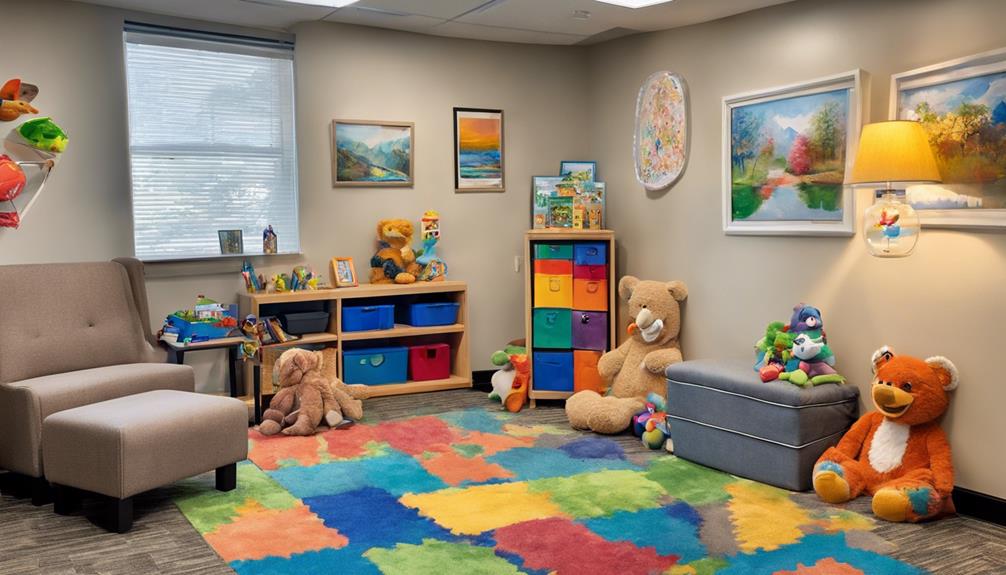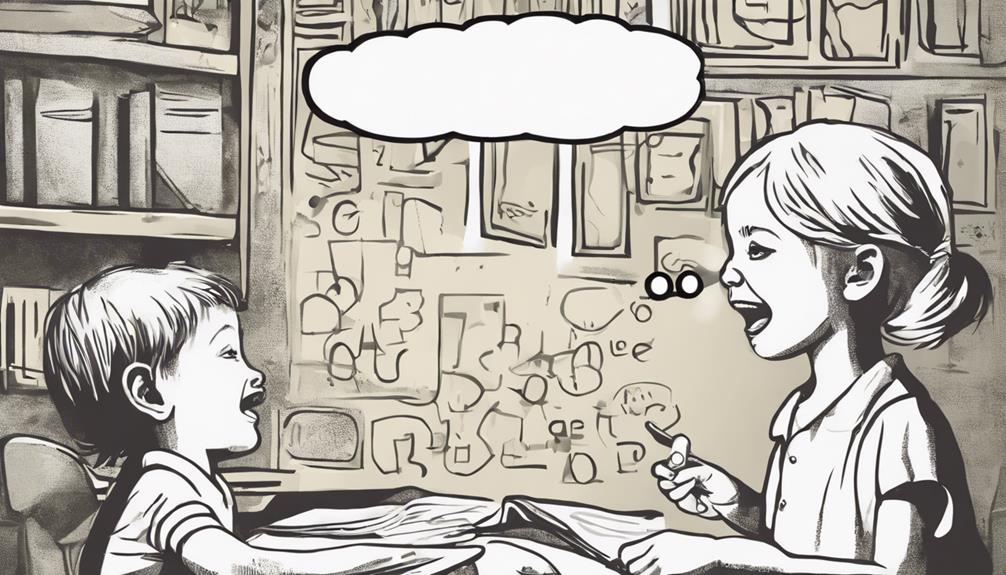Therapies and Interventions
5 Steps to Obtain Your Auditory Verbal Therapy Certification
Uncover the essential roadmap for pursuing Auditory Verbal Therapy Certification and elevate your expertise in this specialized field.

As you begin your journey to obtain your Auditory Verbal Therapy Certification, consider it similar to navigating a path marked by clear signs guiding you along.
Each step in this process holds its own significance, leading you towards a professional milestone that amplifies your impact in the field.
By understanding these 5 crucial stages, you'll be equipped to navigate the requirements and complexities of attaining this esteemed certification, ensuring a solid foundation for your career in auditory verbal therapy.
Key Takeaways
- Choose an accredited institution for 80 hours of post-grad study and supervised therapy.
- Engage in a 3-year mentorship with an LSLS-certified professional for expertise.
- Complete 700 supervised therapy hours to qualify for LSLS Cert AVT certification.
- Pass a rigorous certification exam to demonstrate proficiency in Auditory Verbal Therapy.
Eligibility Criteria
To be eligible for Auditory Verbal Therapy certification, individuals must hold a degree in audiology, speech therapy, or be a Teacher of the Deaf. This certification process is crucial for those aiming to specialize in working with children with hearing loss. The certification, known as the LSLS Cert AVT, ensures that professionals are equipped with the necessary skills to provide effective auditory verbal therapy. This specialized form of therapy focuses on developing listening and spoken language skills in children who are deaf or hard of hearing.
Becoming an LSLS-certified professional involves a comprehensive training program that includes completing 80 hours of post-graduate study in Listening and Spoken Language, as well as accumulating a minimum of 700 clocked hours of supervised therapy. Additionally, candidates must work under the guidance of an LSLS-certified mentor for three years and participate in 150 hours of AVT-related activities. These stringent requirements are designed to ensure that individuals seeking certification possess the expertise and experience needed to make a positive impact in the lives of children with hearing loss.
Training Program Selection

When selecting a training program for Auditory Verbal Therapy certification, it is essential to choose an institution accredited by Auditory Verbal International. Look for programs that offer a minimum of 80 hours of post-graduate study, supervised therapy hours, and mentoring with an LSLS-certified professional. Online training options can provide flexibility and accessibility, allowing you to balance your studies with other commitments. Additionally, ensure that the program prepares you thoroughly for the LSLS Cert AVT examination, a crucial step towards becoming a certified Listening and Spoken Language Specialist (LSLS)-certified professional.
| Training Program Selection | ||
|---|---|---|
| Accreditation | AV International | |
| Study Hours | 80 post-grad | |
| Supervised Hours | Included | |
| Mentoring | LSLS-certified | professional |
| Online Options | Available |
Clinical Practice Hours
During our pursuit of Auditory Verbal Therapy certification, the completion of a minimum of 700 clocked hours of supervised therapy is a vital requirement for practical experience in implementing Auditory Verbal Therapy techniques. This hands-on experience is essential for honing skills in aiding deaf children with spoken language development through listening.
- Requirement for Certification: Clinical practice hours are a mandatory component for obtaining LSLS Cert AVT certification. These hours demonstrate the candidate's commitment to mastering Auditory Verbal Therapy techniques.
- Supervised Therapy: Candidates must complete these hours under the guidance of an LSLS-certified mentor. This supervision ensures that therapy sessions are conducted effectively and ethically.
- Three Years Mentorship: Working with a mentor for three years allows candidates to deepen their understanding of Auditory Verbal Therapy principles and refine their practical skills. This extended mentorship period is invaluable for aspiring professionals in this field.
Mentorship and Supervision

Mentorship and supervision play crucial roles in guiding candidates through the Auditory Verbal Therapy certification process, ensuring their development of essential skills. Working closely with an LSLS-certified mentor for a minimum of three years is a key requirement for certification. During this period, candidates engage in supervised therapy sessions, accumulating at least 700 clocked hours to gain practical experience.
The mentorship provided offers valuable guidance, support, and feedback, helping candidates hone their abilities in working effectively with deaf children and their families. This personalized approach ensures that candidates are well-prepared to navigate the complexities of Auditory Verbal Therapy and make a positive impact in the lives of those they serve.
Certification Examination
The certification examination in Auditory Verbal Therapy is a pivotal assessment that validates therapists' training and qualifications. To pass the exam and become certified, therapists must demonstrate their well-trained and qualified status. Here are key points regarding the certification examination:
- Written Exam: The certification exam is a written assessment that evaluates therapists' knowledge and skills in Auditory Verbal Therapy.
- Pass the Exam: Passing the exam is essential to obtain certification and showcase therapists' proficiency in this specialized field.
- Education and Service Delivery Requirements: Therapists must meet specific education and service delivery standards to be eligible to sit for the exam, ensuring they're equipped to provide high-quality therapy.
Moreover, as part of the certification process, therapists will undergo observation by a certified professional to further validate their competence in Auditory Verbal Therapy. This examination plays a crucial role in maintaining the standards of practice within the field and ensuring that therapists deliver effective therapy to those in need.
Frequently Asked Questions
What Are the Prerequisites for Auditory Verbal Therapy?
We must hold a degree in audiology, speech therapy, or be a Teacher of the Deaf. Additionally, we need to finish 80 hours of post-graduate study in Listening and Spoken Language.
It's crucial to have at least 700 supervised therapy hours and work with an LSLS-certified mentor for three years. Completing 150 hours in AVT-related activities is also mandatory.
These are the prerequisites for Auditory Verbal Therapy certification.
How Do I Become LSL Certified?
To become LSL certified, candidates must meet several requirements. These include having a degree in audiology, speech therapy, or teaching the deaf. Additionally, completion of 80 hours of post-graduate study in Listening and Spoken Language is necessary. Candidates must also have a minimum of 700 clocked hours of supervised therapy. Working with an LSLS-certified mentor for three years is a requirement to qualify. Lastly, mandatory completion of 150 hours in AVT-related activities is part of the certification process.
What Is AVT in Audiology?
AVT in audiology, or Auditory Verbal Therapy, is a specialized approach focusing on developing spoken language skills for children with hearing loss.
It aims to maximize their listening potential by coaching parents to be language facilitators.
AVT helps children acquire age-appropriate spoken language skills through auditory input.
What Is a Lsls?
LSLS, or Listening and Spoken Language Specialist, focuses on teaching children with hearing loss to listen and speak. LSLS certification requires rigorous training and mentorship, emphasizing the development of spoken language skills.
LSLS specialists collaborate closely with families to support children's language acquisition. This certification signifies expertise in auditory verbal therapy for children with hearing loss. It's a vital role in helping children with hearing impairments thrive through communication.
Conclusion
In conclusion, embarking on the journey to become a certified Auditory Verbal Therapist requires dedication, commitment, and passion for helping individuals with hearing loss. By following the outlined steps and seeking guidance from experienced mentors, we can pave the way towards making a meaningful impact in the lives of those we serve.
Remember, the road to certification may be challenging, but the rewards of becoming an AVT are immeasurable. Let's embrace this opportunity to transform lives through the power of communication.
Jamie is one of the creative forces behind the words that resonate with our audience at Deaf Vibes. With a passion for storytelling and advocacy, Jamie delves into topics that matter deeply to the deaf and hard-of-hearing community. Jamie’s articles are crafted with empathy, insight, and a commitment to positive change, from exploring the latest advancements in hearing technologies to shedding light on the everyday challenges and victories of those within the community. Jamie believes in the power of shared stories to inspire action, foster understanding, and create a more inclusive world for everyone.
Therapies and Interventions
3 Benefits of Speech Therapy in Private Practice
A deep dive into the advantages of private speech therapy will revolutionize your understanding of personalized care and transformative outcomes.

Let's face it – navigating the world of speech therapy can be a bit overwhelming. However, when it comes to private practice, the benefits are undoubtedly worth exploring.
From the tailored treatment plans that cater to individual needs to the enhanced therapy experience, private speech therapy offers a unique approach that yields promising results.
But that's just the beginning; there's more to uncover about how this specialized form of therapy can truly transform lives.
Key Takeaways
- Tailored treatment plans for unique challenges and goals
- Individualized care leading to positive outcomes
- Enhanced communication skills through personalized interventions
- Supportive environment for faster development and better results
Personalized Treatment Plans
In private speech therapy, we tailor treatment plans to address the unique communication challenges and goals of each individual. As speech therapy providers in private practice, our primary focus is on creating a treatment plan that's personalized to meet the specific needs of our clients. By conducting thorough assessments, we can identify the areas that require attention and develop customized interventions for optimal progress.
Individualized attention is at the core of our approach, allowing us to implement personalized strategies that cater to the client's learning style and preferences. Collaborating closely with clients and their families, we ensure that the treatment plan aligns with the individual's communication objectives. This level of personalization enables us to adjust the plan as needed based on the client's progress and evolving communication needs, providing a tailored and effective path towards improvement.
Finding the right speech therapist who can offer this level of individualized care is essential in achieving successful outcomes in speech therapy. By choosing private speech therapy, individuals can benefit from a treatment plan that's specifically designed to address their unique challenges and goals.
Enhanced Therapy Experience

Enhancing the therapy experience for clients in private practice involves tailoring interventions to meet individual needs and fostering a supportive learning environment. In private speech therapy, therapists can focus on individual goals and closely track progress in a personalized manner.
This tailored therapy approach ensures that clients receive specialized attention with targeted interventions designed to maximize outcomes efficiently. The flexible scheduling options offered in private practice enable more frequent and intensive therapy sessions, enhancing the overall progress.
Therapists have the opportunity to create a comfortable and supportive environment that nurtures faster development and better results. By providing a space where clients feel understood and supported, private practice elevates the therapy experience, leading to more effective outcomes and a positive journey towards improved communication skills.
The individualized care and attention to detail in private speech therapy truly make a difference in the overall therapy experience.
Improved Communication Skills
Private speech therapy in a practice setting plays a pivotal role in fostering improved communication skills for individuals of all ages, enhancing their ability to express themselves effectively and confidently.
When considering the benefits of private speech therapy for improved communication skills, it's essential to acknowledge the tailored treatment plans that address specific speech and language pathology concerns. These individualized plans allow the speech-language pathologist to focus on the client's unique communication needs, promoting enhanced language development and comprehension skills.
Additionally, private speech therapy offers a supportive environment where clients can work on boosting their social communication abilities, leading to better relationships and interactions in daily life.
Moreover, confidence levels are elevated through private speech therapy, empowering individuals to navigate various communication challenges with ease and grace.
Frequently Asked Questions
Why Work in Private Practice as an Slp?
We choose to work in private practice as SLPs because it offers unique opportunities for individualized care, flexibility in treatment plans, and the chance to form strong relationships with our patients.
The autonomy and ability to tailor therapy to meet specific needs motivate us to excel in this setting.
Our passion for helping others drives us to seek out environments where we can make a real difference in people's lives.
What Are the Benefits of Private Speech?
We believe private speech therapy offers unparalleled benefits. The individualized attention and tailored treatment plans in private practice lead to faster progress and improved outcomes. Clients experience flexible scheduling, customized therapies, and a supportive environment conducive to learning.
The one-on-one interaction enhances communication skills and boosts confidence. In private speech therapy, specialized care and unique approaches cater to individual needs, promoting effective social communication skills.
Is Private Speech Therapy Worth It?
Yes, private speech therapy is worth it.
We believe that the personalized attention and tailored treatment plans in private practice can truly make a difference in our clients' progress.
The one-on-one interaction with a licensed speech-language pathologist allows for a more individualized approach, leading to enhanced outcomes.
The comfortable learning environment fosters effective communication and boosts confidence.
In our experience, the benefits of private speech therapy are invaluable for our clients.
What Is the Difference Between Public and Private Speech Therapy?
When comparing public and private speech therapy, the key difference lies in the level of personalized attention. In private practice, we receive tailored sessions that focus on our unique needs and goals, creating a comfortable and efficient learning environment. This individualized approach sets private therapy apart from the potentially larger caseloads and less personalized attention in public settings.
Flexible scheduling options further enhance the client's experience and progress.
Conclusion
In conclusion, private speech therapy is like a tailor-made suit for your communication needs, offering a personalized experience that can boost your skills and confidence.
With specialized treatment plans and individualized attention, this form of therapy can help you unlock your full potential and communicate with clarity and ease.
So why not take the leap and invest in your communication journey? The benefits are endless, and the results will speak for themselves.
Therapies and Interventions
10 Picture Scenes for Speech Therapy Success
Foster language growth and spark curiosity with 10 captivating picture scenes designed to revolutionize speech therapy outcomes.

Imagine stepping into a vibrant world where every picture scene is a gateway to improving speech therapy outcomes. These 10 carefully curated visuals offer a dynamic platform for enhancing communication skills in young learners.
From unraveling hidden mysteries to crafting intricate sentences, each scene holds a key to unlocking the potential of every speech therapy session. Explore the power of imagery and creativity in transforming language development with these engaging tools.
Key Takeaways
- Picture scenes aid in language development and storytelling skills.
- Visual aids enhance comprehension, engagement, and vocabulary.
- Language development strategies improve articulation and participation.
- WH question targeting boosts critical thinking and expressive language.
Action Picture Scenes
In our speech therapy sessions, we often rely on action picture scenes to engage our young learners and enhance their language skills effectively. These scenes are invaluable tools for targeting action vocabulary and expressive language development. By depicting various actions performed by people or animals, these scenes provide visual prompts that help children practice using new vocabulary words and forming sentences. Through these visual aids, we can stimulate storytelling skills and encourage the use of expressive language in our therapy sessions.
Utilizing action picture scenes allows us to make language learning more interactive and engaging for our young clients. The dynamic nature of these scenes captures the children's attention and facilitates their understanding of verbs and sentence formation. As speech therapists, we find that incorporating action picture scenes into our sessions not only makes the learning process more enjoyable but also significantly contributes to the children's language development.
Colorful Picture Scenes

When it comes to speech therapy, colorful picture scenes play a pivotal role in engaging young learners and fostering effective communication. These vibrant visual aids serve as powerful tools to stimulate language development and enhance vocabulary skills.
Visual Aids for Therapy
Utilizing colorful picture scenes in speech therapy sessions enhances object recognition and vocabulary development, creating an engaging and effective learning environment. Visual aids play a crucial role in speech therapy by making sessions more interactive and stimulating for clients.
Here are three key benefits of incorporating colorful picture scenes:
- Improved Understanding: Colorful visuals help in conveying new concepts more clearly, aiding in better comprehension during therapy sessions.
- Increased Engagement: The use of vibrant colors captures attention and motivates participants, leading to higher levels of involvement and enjoyment in activities.
- Enhanced Language Skills: Colorful picture scenes are particularly useful for practicing narrative skills, describing scenes, and working on WH questions, promoting the development of language abilities.
Engaging Communication Tools
Colorful picture scenes serve as powerful communication tools, enriching speech therapy sessions with enhanced engagement and accelerated language development. The vibrant visuals not only enhance object recognition but also facilitate picture naming, making learning more effective.
One of the best parts of using colorful picture scenes is their ability to improve understanding of new concepts and speed up reaction times, aiding in quicker progress during therapy. These materials are particularly motivating for children, increasing their participation and focus in sessions.
Stimulating Language Development
Enhancing language development through vibrant picture scenes is a proven strategy in speech therapy sessions, fostering engagement and accelerating learning outcomes. When it comes to speech therapy, incorporating colorful picture scenes can significantly benefit children's articulation and language skills.
- Colorful scenes help enhance object recognition and vocabulary development.
- The use of color facilitates understanding of new concepts and improves reaction times in children.
- Colorful materials are more rewarding and motivating for kids during speech therapy sessions.
Picture Hierarchy

Starting with concrete objects, picture hierarchy in speech therapy gradually progresses to abstract symbols like written words to support language development and communication goals. This sequential approach is essential for individuals undergoing speech therapy as it provides a structured path for learning and understanding language concepts. By beginning with tangible objects, such as toys or everyday items, clients can easily grasp basic vocabulary and concepts before advancing to more complex visual aids like color photographs and symbols. The use of varied materials, including black and white photographs and miniature objects, offers diverse learning experiences that cater to different learning styles.
As speech therapists, incorporating color drawings, symbols, and written words into sessions further enriches language development at various levels. This method not only aids in vocabulary expansion but also targets goals related to grammar and comprehension. Understanding and implementing the picture hierarchy allows therapists to tailor materials to individual needs effectively. By recognizing the importance of this hierarchy, therapists can create customized therapy plans that maximize progress and ultimately enhance communication skills.
Real Picture Scenes for Narratives

Let's talk about how real picture scenes can truly elevate the narrative skills of those in speech therapy.
By using authentic images, we can guide clients to craft detailed stories with a strong structure, fostering better language organization.
These scenes also encourage clients to hone their inferencing abilities and practice predicting outcomes based on visual cues.
Scene Descriptions for Stories
Real picture scenes serve as dynamic tools for cultivating narrative skills in speech therapy, fostering engaging storytelling abilities in clients. When using these scenes for story descriptions, therapists can guide clients to:
- Develop Detailed Stories: Real picture scenes encourage clients to create elaborate narratives by observing and interpreting the visual cues present.
- Enhance Language Skills: Through the process of describing the scenes, clients work on sequencing, describing, and inferencing, improving their overall narrative language abilities.
- Structure Compelling Narratives: Therapists can teach clients how to organize their stories effectively, incorporating key elements such as characters, settings, and plot developments.
Enhancing Language Skills
Enhancing language skills through the use of real picture scenes in therapy sessions provides concrete visual cues that aid in developing narrative abilities and fostering language proficiency. Real pictures serve as effective tools for targeting skills such as inferencing, predicting, describing, and answering WH questions.
By engaging students in storytelling activities, these scenes enhance expressive language abilities. Additionally, incorporating real photos supports vocabulary development and grammar skills through contextual learning. The use of real picture scenes not only makes learning language concepts more meaningful but also ensures an engaging therapeutic experience.
Therapists find that these visual prompts create a dynamic environment for language practice, helping individuals improve their communication skills in a practical and interactive manner.
Inferencing With Real Pictures

Utilizing authentic images in speech therapy sessions can greatly enhance clients' ability to infer and draw conclusions from visual stimuli. When incorporating real pictures for inferencing activities, clients can benefit in several ways:
- Developing Critical Thinking: Real pictures prompt clients to make educated guesses based on visual cues, fostering critical thinking skills essential for effective communication.
- Enhancing Problem-Solving Abilities: Engaging with real pictures encourages clients to make logical connections and draw conclusions, improving their problem-solving skills in various communication contexts.
- Practicing Predictive Skills: Real pictures provide context for inferencing tasks, allowing clients to practice predicting outcomes and drawing logical inferences based on the visual information presented.
Describing Real Pictures

Moving from inferring with real pictures to describing them involves honing our ability to articulate detailed observations and express them effectively in speech therapy sessions. Real pictures serve as invaluable tools in teaching descriptive language skills. By describing these images, clients can enhance their vocabulary and expressive language abilities. Encouraging clients to provide detailed and accurate descriptions of objects and scenes through real picture scenes can significantly boost engagement and motivation during therapy activities. Moreover, practicing the skill of describing real pictures aids in the development of observational and communication skills crucial for effective expression.
| Benefits of Describing Real Pictures | |
|---|---|
| Improves vocabulary | Enhances expressive language |
| Encourages detailed descriptions | Boosts engagement and motivation |
| Develops observational skills | Fosters effective communication |
Targeting WH Questions

When working on targeting WH questions, it's important to practice these questions consistently to build proficiency.
By applying specific WH question strategies, clients can strengthen their comprehension skills effectively.
Let's guide clients in utilizing these strategies to enhance their critical thinking abilities.
WH Questions Practice
In speech therapy sessions, we focus on targeting question words like who, what, where, why, and how through WH questions practice to enhance language skills and critical thinking abilities.
Here are three key benefits of WH questions practice in speech therapy:
- Develops Language Skills: By prompting clients to answer questions related to picture scenes, WH questions practice helps improve comprehension and expressive language abilities.
- Enhances Critical Thinking: Engaging with WH questions encourages clients to think critically about the content they're observing, leading to improved reasoning skills.
- Improves Communication: Utilizing WH questions in therapy sessions aids in enhancing communication skills, as clients are prompted to articulate their thoughts and ideas effectively.
Applying WH Strategies
Let's explore how applying WH strategies, specifically targeting WH questions, can significantly benefit speech therapy sessions. By focusing on who, what, where, when, why, and how, we enhance language comprehension and critical thinking skills. Using real picture scenes in therapy allows clients to practice answering WH questions effectively, improving inferencing, predicting, and storytelling abilities. This approach aids in developing expressive language skills and provides visual context for clients to understand and respond to different types of questions. Check out the table below to see how incorporating WH questions with picture scenes can create a dynamic and engaging therapy environment:
| Benefit | Description | Outcome |
|---|---|---|
| Enhanced Comprehension | Clients grasp information better through visual context | Improved understanding of the questions |
| Critical Thinking Skills | Encourages clients to think deeply about the scenario presented | Enhanced critical thinking abilities |
| Expressive Language Development | Helps clients articulate their thoughts and responses | Improved expressive language skills |
| Inferencing Practice | Clients learn to draw conclusions from visual cues | Strengthened inferencing skills |
| Storytelling Improvement | Enables clients to narrate stories based on the picture scenes | Enhanced storytelling abilities |
Vocabulary Building

Utilizing picture scenes is an effective method for enhancing vocabulary skills during speech therapy sessions. Picture scenes offer a visual context that aids in teaching and reinforcing new words, ultimately improving understanding and retention. Here are three key ways in which vocabulary building through picture scenes can benefit speech therapy sessions:
- Enhanced Vocabulary Acquisition: Picture scenes provide a tangible reference point for clients to associate with new words, making it easier for them to grasp the meaning and usage of these terms.
- Interactive Learning Experience: By incorporating picture scenes, therapy sessions become more engaging and interactive, fostering a dynamic learning environment that encourages active participation and retention of vocabulary.
- Expanded Vocabulary Repertoire: Visual aids like picture scenes help expand a client's vocabulary repertoire effectively, enabling them to express themselves more fluently and accurately in various contexts.
Sentence Formulation Practice

Engaging in sentence formulation practice with picture scenes enhances our expressive language skills effectively during speech therapy sessions. This activity allows us to describe hidden objects within the scenes using complete sentences, fostering vocabulary growth and improving grammar and sentence structure.
The visual support from the picture scenes aids us in accurately constructing descriptive sentences, making the learning process more accessible and engaging. Sentence formulation practice with picture scenes is particularly beneficial for preschool and elementary students working towards achieving language goals.
Grammar Practice

Enhancing our grammar skills through interactive picture scenes adds a dynamic element to speech therapy sessions. By incorporating grammar activities into these engaging visuals, we can effectively improve language skills and comprehension.
Here's why grammar practice within picture scenes is beneficial:
- Visual Context: Picture scenes provide a visual context for grammar concepts, making learning more interactive and fun.
- Targeted Language Goals: Using picture scenes for grammar practice allows us to target specific language goals in a meaningful and personalized way.
- Enhanced Skills: Grammar practice within picture scenes not only improves grammar but also enhances articulation, vocabulary, and sentence structure skills.
With these benefits in mind, integrating grammar practice into picture scenes can significantly enhance the effectiveness of speech therapy sessions, making learning both enjoyable and productive.
Frequently Asked Questions
How Do You Use Picture Scenes in Speech Therapy?
We use picture scenes in speech therapy to enhance language skills and boost engagement. By providing visual prompts, we create a context for practicing articulation, forming sentences, and storytelling.
These scenes help target specific goals like describing, inferencing, and answering WH questions. Children love the interactive nature of these sessions, making therapy enjoyable. Real pictures in our materials aid comprehension and retention for students of all ages.
What Are Picture Scenes and Sentence Formulation?
Picture scenes and sentence formulation involve using visual prompts to help clients develop their descriptive language skills.
By observing scenes with various objects and characters, clients can practice constructing detailed sentences. This process enhances expressive language, vocabulary, and storytelling abilities.
Engaging with picture scenes encourages clients to create meaningful sentences, fostering communication skills.
Through this practice, clients can improve their language production and sentence structure in speech therapy sessions.
What Is the Success Rate of Speech Therapy?
The success rate of speech therapy varies depending on the individual's condition and therapy goals. Research indicates that speech therapy can be highly effective in enhancing communication skills for many. Success is often gauged by improvements in speech clarity, language development, and communication effectiveness.
Early intervention and regular therapy sessions are crucial for positive outcomes. Incorporating engaging materials like picture scenes can further boost the success of speech therapy by promoting effective learning.
What Are the Visual Cues for Speech Therapy?
Visual cues in speech therapy encompass pictures, gestures, and other aids that support communication and language development. These tools enhance articulation, vocabulary, and overall communication skills for individuals with speech and language disorders.
They improve understanding, engagement, and learning during therapy sessions. Visual cues are especially beneficial for those struggling with auditory processing or verbal instructions.
Incorporating these cues makes learning interactive, effective, and enjoyable for clients of all ages.
Conclusion
In the vibrant world of speech therapy, these 10 picture scenes serve as colorful windows of opportunity for young learners to explore language skills. Like a painter adding brushstrokes to a masterpiece, these scenes help children develop their speech and communication abilities with creativity and joy.
With each scene, hidden treasures of language are uncovered, painting a path towards success in speech therapy.
Therapies and Interventions
10 Auditory Memory IEP Goals for Speech Therapy Success
Get ready to supercharge auditory memory skills with these 10 targeted IEP goals in speech therapy.

Enhancing auditory memory in speech therapy is vital for children's cognitive development.
With 10 targeted IEP goals focusing on auditory memory skills, therapists can help children achieve success in recalling and processing spoken information effectively.
From improving memory span to enhancing attention and sequencing abilities, these goals aim to strengthen auditory processing speed and memory recall.
By tailoring goals to each child's unique needs and monitoring progress, therapists play a crucial role in enhancing auditory memory skills.
Key Takeaways
- Set specific auditory memory goals in IEP for targeted improvement.
- Use repetition and association techniques to strengthen memory recall.
- Engage in multi-sensory activities to enhance auditory memory development.
- Incorporate auditory sequencing tasks to improve working memory skills.
Developing Auditory Attention Skills
Developing auditory attention skills is crucial in speech therapy for enhancing the ability to focus on and remember auditory information effectively. In speech therapy, we focus on improving auditory memory through targeted activities and exercises tailored to each individual's needs. By practicing skills such as repeating spoken words, following instructions, and accurately recalling auditory information, we aim to strengthen auditory attention abilities. These skills are vital not only for academic success but also for navigating social interactions and daily communication with confidence.
Individualized Education Program (IEP) goals often include objectives related to auditory memory enhancement. By setting specific targets for improving auditory attention skills within the IEP, we can track progress and tailor interventions accordingly. Speech therapists work closely with individuals with speech and language difficulties to design activities that challenge and strengthen their auditory memory capacities. As progress is made in developing auditory attention skills, individuals typically demonstrate improved abilities to recall, follow, and repeat spoken information accurately, leading to enhanced communication and overall well-being.
Improving Auditory Discrimination Abilities

Improving auditory discrimination abilities is essential for enhancing speech and language skills in therapy sessions. Auditory discrimination involves the ability to differentiate between similar sounds or words, a crucial skill in speech therapy. By targeting auditory discrimination through specific auditory memory IEP goals, individuals can learn to distinguish speech sounds accurately.
This training is particularly beneficial for those with auditory processing disorders, as it can improve comprehension and communication during therapy sessions. Enhancing auditory discrimination not only aids in recognizing subtle differences in sounds but also contributes to overall speech and language development. Speech therapists focus on honing these skills to ensure that individuals can effectively distinguish between various speech sounds, leading to improved auditory memory and better speech outcomes in therapy.
Through dedicated practice and targeted interventions, individuals can make significant strides in their auditory discrimination abilities, ultimately enhancing their overall speech therapy experience.
Enhancing Auditory Sequencing Proficiency
Enhancing auditory sequencing proficiency is a vital component of advancing speech and language skills in therapy sessions. It involves the ability to accurately recall and repeat a sequence of auditory information, which is essential for following instructions, understanding narratives, and retaining information in the correct order.
When setting IEP goals for auditory sequencing, focusing on improving working memory skills can enhance the accuracy and speed of recalling spoken sequences. These goals may include tasks like repeating spoken numbers, recalling lists in order, or reproducing sequences of sounds accurately.
Strengthening Auditory Memory Recall

While addressing auditory memory recall, we aim to strengthen the ability to accurately retain and recall spoken information. This is crucial for achieving success in academic and daily life tasks. Here are three key strategies to enhance auditory memory recall through IEP goals in Speech Therapy:
- Repetition: Encouraging repetition of spoken information helps reinforce memory recall and retention.
- Association Techniques: Teaching individuals to associate new information with existing knowledge can aid in memory recall.
- Multi-Sensory Activities: Engaging multiple senses during learning, such as combining visual aids with auditory input, can improve memory recall abilities.
Building Auditory Processing Speed
Addressing auditory processing speed involves implementing targeted exercises and strategies to enhance the interpretation and response time to auditory information. As Speech Language Pathologists, setting specific IEP goals aimed at improving auditory processing speed is crucial. By incorporating activities that challenge quick processing of auditory information, individuals can strengthen their ability to understand and respond promptly in various situations. These exercises may include listening to rapid speech, following multi-step directions, and engaging in activities that require quick auditory discrimination.
Improving auditory processing speed can significantly benefit individuals in academic settings, social interactions, and overall communication skills. Through consistent practice and tailored interventions, individuals can enhance their ability to process auditory information efficiently. Setting clear IEP goals focused on building auditory processing speed can lead to improved academic outcomes, better comprehension of verbal instructions, and enhanced participation in conversations. By working collaboratively with Speech Language Pathologists, individuals can make strides in developing this essential skill for effective communication.
Enhancing Auditory Comprehension Skills

Our focus lies in honing the essential auditory comprehension skills necessary for effective communication and interaction. When it comes to setting IEP goals for improving auditory memory in speech therapy, enhancing auditory comprehension skills is crucial.
Here are some strategies to achieve this:
- Repetition: Repeating information helps reinforce understanding and retention.
- Visual aids: Utilizing visual tools alongside spoken information can aid in comprehension.
- Chunking information: Breaking down spoken content into smaller, manageable chunks facilitates better understanding.
In speech therapy sessions, IEP goals may include tasks such as recalling spoken instructions, following auditory directions, and summarizing spoken content. Progress in enhancing auditory comprehension skills not only improves communication but also boosts academic performance and social interactions.
Improving Auditory Memory Span

To enhance auditory memory span, it is essential to implement targeted strategies that focus on improving the ability to recall and repeat sequences of spoken information accurately. Setting IEP goals for auditory memory span involves tasks such as recalling spoken words, following instructions, and repeating numbers. Effective strategies for improving auditory memory span include repetition, chunking information, and using mnemonic devices. Progress in auditory memory span can be measured through assessments, observations, and data collection to track improvements over time.
| Strategies for Improving Auditory Memory Span | Examples |
|---|---|
| Repetition | Repeating sequences of numbers or words multiple times. |
| Chunking Information | Grouping information into smaller, manageable chunks. |
| Mnemonic Devices | Using memory aids like acronyms or visualization techniques. |
| Data Collection | Recording performance on memory tasks to monitor progress. |
Enhancing Auditory Memory for Instructions

Enhancing auditory memory for instructions involves honing the ability to accurately retain and recall spoken directives. When setting IEP goals for auditory memory in speech therapy, it's crucial to focus on improving the capacity to follow and execute multi-step directions effectively.
To enhance auditory memory for instructions, consider the following strategies:
- Repetition: Encourage repeating instructions to reinforce memory retention.
- Chunking Information: Break down complex instructions into smaller, manageable chunks.
- Visual Aids: Utilize visual cues or diagrams to support auditory memory development.
Strengthening Auditory Memory for Details

As speech therapists, we recognize the importance of strengthening auditory memory for remembering intricate details effectively.
By implementing detail retention strategies, individuals can enhance their memory skills and improve their ability to recall specific information accurately.
These techniques play a crucial role in supporting better comprehension and retention of crucial details in various conversations and instructions.
Detail Retention Strategies
Implementing repetition and rehearsal techniques is fundamental in strengthening auditory memory for details. To enhance detail retention, we recommend the following strategies:
- Encourage summarizing information actively to improve retention.
- Utilize visual aids and graphic organizers to support memory recall.
- Break down complex information into smaller, manageable chunks for better processing.
Enhancing Memory Skills
How can we effectively strengthen auditory memory for details in speech therapy to enhance memory skills?
Strengthening auditory memory skills is crucial for individuals to accurately recall and retain specific details from spoken information. This enhancement plays a vital role in facilitating the ability to follow multi-step directions with precision.
By developing auditory memory abilities, individuals can better remember sequences of unrelated spoken syllables and reproduce complex spoken sentences more accurately. Speech therapy focused on strengthening auditory memory can significantly improve an individual's capacity to retain and recall important details, such as phone numbers or instructions.
Setting IEP goals that target enhancing auditory memory skills can lead to notable advancements in an individual's ability to process and remember information effectively.
Developing Auditory Memory for Conversations

Improving auditory memory for conversations involves actively engaging in strategies that enhance the retention and recall of spoken information.
When working towards developing auditory memory skills specifically for conversations in speech therapy, it's crucial to focus on the following key points:
- Recalling Spoken Information: Practice recalling details from recent conversations to improve memory retention.
- Participating Actively: Engage in conversations by listening attentively and responding appropriately to strengthen auditory memory.
- Summarizing Discussions: Summarize conversations after they occur to reinforce memory and understanding of the content.
Frequently Asked Questions
What Are the Memory Strategies Goal for Speech Therapy?
In speech therapy, we focus on memory strategies to improve auditory memory skills. These goals help us recall and retain spoken information like words and instructions.
By using exercises like repetition and mnemonic devices, we can enhance memory. Visual aids and chunking info also support auditory memory.
Setting measurable goals allows us to track progress and customize interventions for effective therapy. These strategies lead to better communication and language development.
What Are the Goals for Auditory Discrimination in Speech Therapy?
In speech therapy, our goals for auditory discrimination focus on improving the ability to differentiate between similar sounds or words. By enhancing listening skills, phonemic awareness, and speech sound discrimination, we aim to strengthen auditory processing essential for speech and language development.
Specific objectives may include distinguishing between minimal pairs like 'pat' and 'bat' or 'ship' and 'sip.' Achieving these goals can lead to enhanced communication, speech clarity, and overall language proficiency.
What Is the Goal of Auditory Closure Speech Therapy?
We aim to enhance auditory closure skills in therapy to boost comprehension and communication. By filling in missing parts of spoken information, we help improve listening accuracy and memory.
Success in this area can lead to better academic performance and social interactions. It's a vital aspect of speech therapy that aids in overall language development.
What Are the IEP Goals for Phonological Memory?
We aim to enhance phonological memory through IEP goals. These goals target the ability to process and recall auditory information accurately. Objectives include improving word retention, following spoken instructions, and recalling sound sequences.
Strengthening auditory processing skills aids in effective communication and learning. By setting measurable phonological memory goals, individuals with auditory challenges can develop strategies for better information retention and retrieval.
These goals in an IEP can lead to improved speech therapy outcomes and academic success.
Conclusion
In conclusion, setting auditory memory IEP goals in speech therapy is essential for helping children improve their ability to recall spoken information accurately.
Just like a musician fine-tuning their ear to play a perfect melody, these goals help children sharpen their listening skills to better understand and retain information.
By focusing on specific auditory memory skills tailored to each child's needs, speech therapists can guide them towards success in communication and learning.
Jamie is one of the creative forces behind the words that resonate with our audience at Deaf Vibes. With a passion for storytelling and advocacy, Jamie delves into topics that matter deeply to the deaf and hard-of-hearing community. Jamie’s articles are crafted with empathy, insight, and a commitment to positive change, from exploring the latest advancements in hearing technologies to shedding light on the everyday challenges and victories of those within the community. Jamie believes in the power of shared stories to inspire action, foster understanding, and create a more inclusive world for everyone.
-

 Navigating the VA System2 months ago
Navigating the VA System2 months agoVA Hearing Loss Rating Chart: Understanding Disability Compensation
-

 Therapies and Interventions3 weeks ago
Therapies and Interventions3 weeks ago10 Auditory Processing Goals for Effective Speech Therapy
-

 Vetted2 months ago
Vetted2 months ago15 Best Oticon Hearing Aids to Improve Your Hearing in 2024
-

 Navigating the VA System1 month ago
Navigating the VA System1 month agoUnderstanding Bilateral Hearing Loss VA Rating Criteria
-

 Tinnitus2 months ago
Tinnitus2 months agoVA's Rating System for Tinnitus and Hearing Loss Explained
-

 Sign Language2 weeks ago
Sign Language2 weeks agoMastering the Art of Signing Letters in Sign Language
-

 Sign Language3 weeks ago
Sign Language3 weeks agoSign Language Emoji Translator: How to Communicate With Gestures
-

 Sign Language3 months ago
Sign Language3 months agoMedical Sign Language PDF: A Comprehensive How-To Guide



















